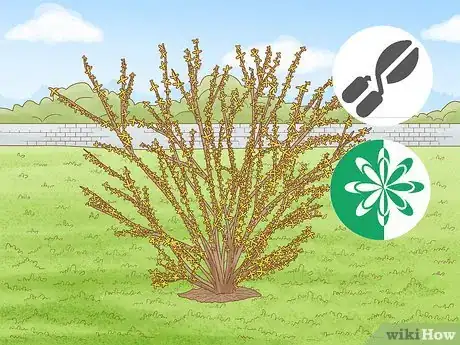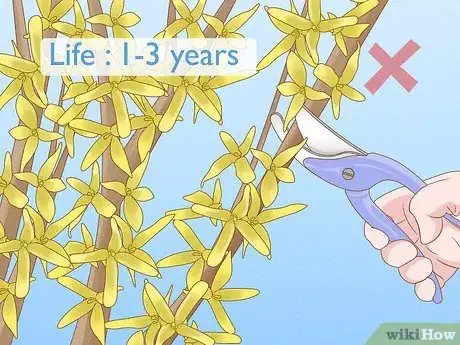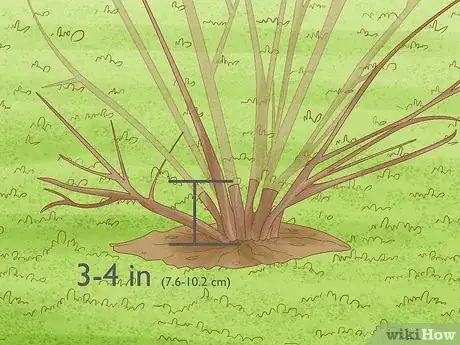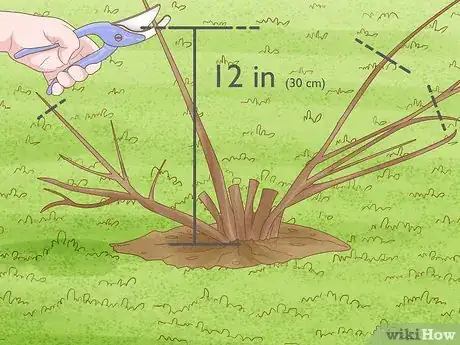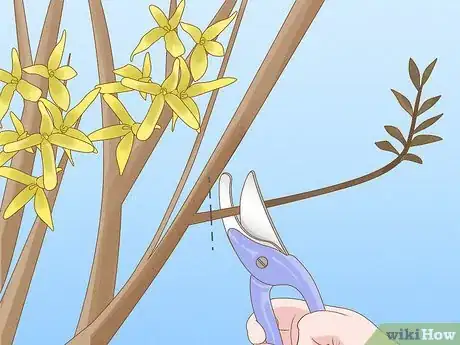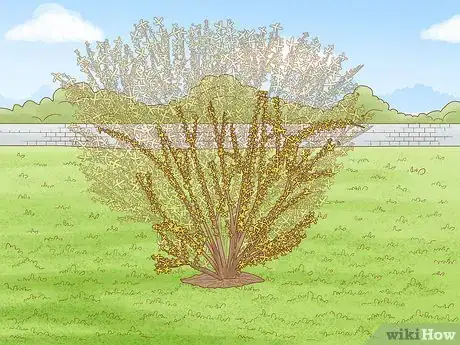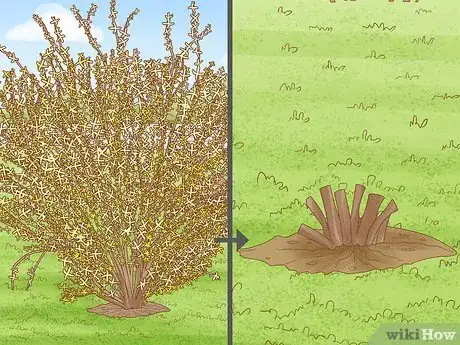This article was co-authored by Lauren Kurtz. Lauren Kurtz is a Naturalist and Horticultural Specialist. Lauren has worked for Aurora, Colorado managing the Water-Wise Garden at Aurora Municipal Center for the Water Conservation Department. She earned a BA in Environmental and Sustainability Studies from Western Michigan University in 2014.
There are 9 references cited in this article, which can be found at the bottom of the page.
wikiHow marks an article as reader-approved once it receives enough positive feedback. In this case, 95% of readers who voted found the article helpful, earning it our reader-approved status.
This article has been viewed 83,090 times.
Forsythias are large bushes with bright yellow flowers that bloom in the early springtime. When pruning, aim to give each stem lots of room as it grows. If you want your plant to grow as many flowers as possible, prune it in the springtime after it blooms. If you want to tame an overgrown plant, prune it in the summer, fall, or winter. Prune your forsythias once a year so your plants stay healthy and look great!
Steps
Pruning at the Right Time
-
1Prune forsythia plants right after they finish blooming in the spring. Wait for your yellow flowers to fade and for the leaves to grow. At this point, the plant starts to develop next year's buds, and the plant carries the buds through the fall and winter season. This is the best time to prune your forsythia.[1]
-
2Prune in the summer, fall, or winter to reduce the number of flowers. If you wait to prune your forsythias until after the springtime, the number of flowers that your plant yields next season will be considerably less.[2]
- This is a good idea if your bush is large and unruly and you want to tame it back.
- You may sacrifice a season of flowers, but your forsythia bush will look much better the next year.
Advertisement -
3Avoid pruning your forsythia when the plant is 1-3 years old. Young forsythias need little to no pruning. Only when they mature should you prune them once a year. If you want to help maintain the shape of the plant as it grows, you can snip off a few longer stems once a year, though this is not required.[3]
- Letting the plant take its natural shape helps it establish a healthy root system.
Pruning Mature Forsythias
-
1Remove a quarter of the oldest stems by cutting them at ground level. The stems get thicker as they age, and they start to rub against each other towards the inside of the shrub. This can cause disease and infection. To prevent this, use a handsaw to remove some of your old, thick stems. Move your handsaw back and forth quickly to make your cuts.[4]
- The largest stems have the thickest diameter.
- The oldest stems typically are also the tallest. By getting rid of them, you reduce the overall height of your shrub.
- If you can’t reach the very middle of the shrub’s base, cut it to 3–4 in (7.6–10.2 cm) from the ground.
- Do this after your plants mature to about 5-6 years old. This way, they are large enough to support such a massive pruning.[5]
-
2Cut the stems to 12 in (30 cm) or more if you want to encourage growth. Use a pair of loppers or a fine-tooth handsaw to cut your large stems. Instead of cutting them at the ground, leave about 1 ft (0.30 m) of the stem. This way, new stems can grow from the remaining portion of the branch.[6]
- Trimming the top of the stem off helps reduce the height of your plant while promoting a spot for new shoots to grow.
-
3Remove branches low to the ground to maintain the shape of the plant. Sometimes, the forsythia plant grows branches toward the base. This does not look the best, since most of the flowers bloom at the canopy of the plant. To reshape your plant, simply cut off these branches using your pruning shears. Make your cut where the branch first sprouts off the other stem.[7]
- If you don’t remove low branches, they may start to root to the ground.
-
4Get rid of any dead, bent, or split stems to keep your plant healthy. As perennials grow, they often produce a few dead branches. In addition, the dense stems may start to touch or rub together. If you previously trimmed a stem, new “split stems” may grow where the cut was made. While these instances occur normally as the plant grows, they can take away nutrients and expose the plant to infection.[8]
- If you notice any stems growing inward rather than outward, these should be pruned as well.
- Dead, bent, and split stems also change the look of your shrub.
-
5Cut branches back to their point of origin to thin out the canopy. Use pruning shears or loppers to remove any excess branches towards the top of your plant. This helps preserve the natural shape of your forsythia while getting rid of the bulk. Do this for branches that point inward, branches that cross, and branches that are rubbing against other branches. In addition, cut off some of the very tall branches.[9]
- Removing branches displays the natural shape of the plant. Keeping your forsythia open allows light and air into the middle of the shrub, which helps it grow healthy.
-
6Crop the stems to 4–5 in (10–13 cm) if they are drastically overgrown. Only do this if your plant is an overgrown mess and starts to take over your garden bed. Using loppers, cut all of your stems to the ground. Make your cuts about 4–5 in (10–13 cm) from the ground so new shoots can start to grow. After this, remove excess branches to keep your plant open and airy.[10]
- For best results, do this in late winter or early spring.
- Blooming will be reduced or nonexistent after a dramatic pruning.
- After a few years, your plant will look full again.
Things You’ll Need
- Pruning shears
- Loppers
- Handsaw
Warnings
- If left unpruned, forsythia plants can get very large and take over other areas of your garden.⧼thumbs_response⧽
- Avoid cutting off the top of your forsythia with hedge clippers. While this may get rid of the bulk of your shrub faster, the plant will grow excessive, dense growth where you make your cuts.[11]⧼thumbs_response⧽
- Avoid trimming your forsythia into a hedge. This results in more branches to clip off and less flowers overall. If you want your forsythia to look its best, let it grow outward rather than shaping it into a hedge. Hedge-shaped forsythias require pruning several times a year rather than just 1 time in the spring.⧼thumbs_response⧽
References
- ↑ http://www.amateurgardening.com/how-to/pruning-forsythia-the-right-way-3316
- ↑ https://youtu.be/ZWdn5xaA2MA?t=1m18s
- ↑ https://www.gardenfocused.co.uk/shrub/forsythia.php
- ↑ https://youtu.be/ZWdn5xaA2MA?t=1m43s
- ↑ http://www.amateurgardening.com/how-to/pruning-forsythia-the-right-way-3316
- ↑ https://youtu.be/ZWdn5xaA2MA?t=2m22s
- ↑ https://youtu.be/ZWdn5xaA2MA?t=3m12s
- ↑ https://youtu.be/ZWdn5xaA2MA?t=3m3s
- ↑ https://youtu.be/ZWdn5xaA2MA?t=2m41s
About This Article
You’ll want to prune your forsythia in the spring after its yellow flowers fade and its leaves start to grow so it’ll grow better next year. If your forsythia plant is under 5 years old, it’ll need little to no pruning. However, once they’re 5 or 6, you’ll want to prune them once a year. Aim to cut about a quarter of the oldest, tallest stems from the plant. Cut them low to the ground with a handsaw. If you spot any dead, bent, or split stems, cut them too. To encourage new growth, leave at least 12 inches of the branches. For more tips from our Gardening co-author, including how to reduce the number of flowers on your forsythia, read on!
